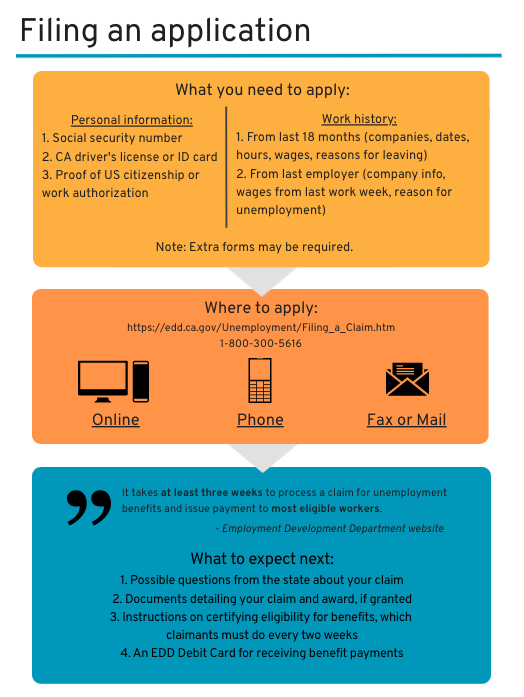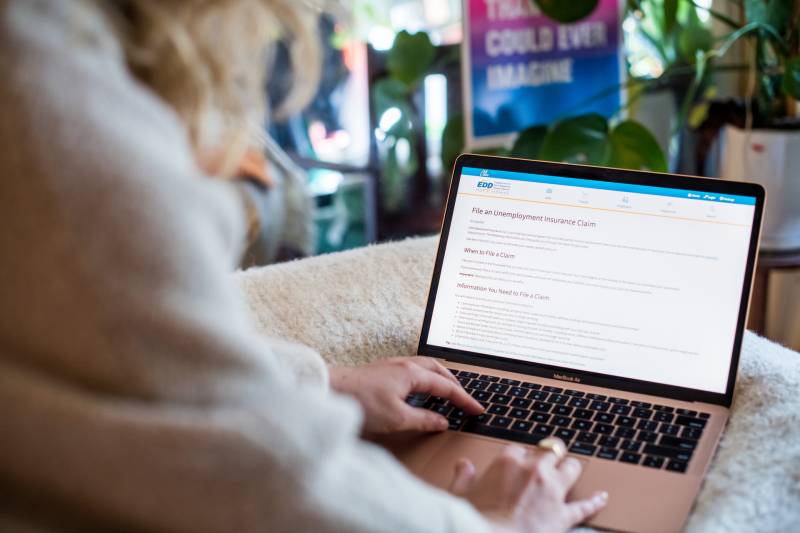Millions of Californians have been hit hard by the pandemic, particularly workers who are young, female or non-white. One survey showed a third of state residents don’t know how they’ll pay next month’s rent. Another researcher estimated that the rate of household food insecurity has doubled.
Why Does it Take So Long to Get Paid?
This summer, the unemployment horror stories started to boil over. As out-of-work Californians slogged through “150 redials” to the unemployment office or long waits for checks docked for previously unknown penalties, The Mercury News reported that just 3.1 million of the more than 5 million California workers who applied for benefits from March to May had received their first checks by early July.
In late September, officials at EDD made the decision to pause accepting unemployment claims until early October, after the release of a "strike team" report commissioned by Gov. Gavin Newsom that highlights the department's need for a massive overhaul to meet the demand of millions of people who are out of work.
The report, released Sept. 19, emphasizes that the department is wholly unequipped to handle its rapidly growing backlog of some 10,000 unemployment claims a day. In a letter to Newsom, EDD Director Sharon Hilliard said the "pause" would allow her department to catch up with its backlog and implement new technologies, strategies and protocols to tackle the overwhelming number of claims.
The department is once again accepting new unemployment insurance claims as of Oct. 5.
All over the state, public officials have been demanding answers and an audit of the EDD after delays process claims that in some cases stretched for months. Confusingly worded questions on forms and a lack of staff to update applications — in addition to reports of technical glitches and unexplained delays — still abound in Facebook support groups and news articles. Officials say that common reasons for holdups include identity verification, missing information on wages and application errors like incomplete work histories.
During its reboot, the EDD worked to launch a system called ID.me to automatically verify the identity of a claimant. The hope is the changes will make it easier for newcomers to file claims, mitigate fraud and help the department work through a backlog of cases. The department says more details about the rollout of the new system are coming soon.
There’s also no denying how drastically the workload has increased. The state processed eight times as many applications during the worst week so far of the coronavirus recession — 1,058,325 in the third week of March — than the worst week after the financial crisis, according to a CalMatters analysis.
How to File for Unemployment in California
Californians who may be missing work because of the coronavirus can apply for benefits through the state's EDD once the agency begins accepting new claims again on Oct. 5. Specific policies instituted as a result of the coronavirus can be seen here (also available in Spanish). The department is providing workers and caregivers various options to collect payment.
Sick or quarantined Californians who are unable to work as a result of the virus can file a disability insurance claim online.
If you're unable to work because you're taking care of a sick or quarantined relative with COVID-19, you can file a paid family leave claim.
Those who have had reduced hours or have lost their job due to their employer shutting down operations can file an unemployment insurance claim.
EDD encourages Californians to check the COVID-19 resources page for developments.
General Eligibility Requirements for California
When filing for unemployment, you must have earned a certain threshold of wages to establish a claim, and be:
- Totally or partially unemployed
- Unemployed through no fault of your own
- Physically able to work
- Available for work
- Ready and willing to accept work immediately
- Actively looking for work
In addition, according to EDD, you must continually meet eligibility requirements — meaning on a weekly basis you must continually prove the points above.
The federal government is allowing new options for states to amend their laws to provide unemployment insurance benefits related to COVID-19. For example, federal law now allows states to pay benefits where:
- An employer temporarily ceases operations due to COVID-19, preventing employees from coming to work.
- An individual is quarantined with the expectation of returning to work after the quarantine is over.
- An individual leaves employment due to a risk of exposure or infection or to care for a family member.
- In addition, federal law does not require an employee to quit in order to receive benefits due to the impact of COVID-19.
Frequently Asked Questions on Unemployment
Frequently asked questions continue to change. The EDD website has an updated list here.
Can I file for unemployment if I am self-employed, an independent contractor or gig worker?
In certain cases, you may be eligible if you meet the following criteria:
- You chose to contribute to unemployment elective coverage and paid contributions to be considered potentially eligible for benefits.
- Your past employer made contributions on your behalf over the past five to 18 months.
- You may have been misclassified as an independent contractor instead of an employee.
- When filing for your unemployment claim, you will be asked for your last employer.
If you own your business or are self-employed, you should list yourself as your last employer. If you are an independent contractor, you should list yourself as your last employer. If you believe you are misclassified as an independent contractor instead of an employee, you should list the business you contract with as your last employer.
Be sure to include:
- The employer name, phone number and address.
- Type of work performed.
- Dates worked.
- Your gross wages and how you were paid (such as hourly or weekly).
- If you are a gig worker, you should list your gig employer as your last employer.
Would I qualify for benefits if I choose to stay home from work due to underlying health conditions and concerns about exposure to the virus?
You can be eligible for benefits if you choose to stay home. Once you file your claim, the department will contact you if they need more information.
Would I qualify for benefits if my child’s school shuts down and I have to miss work to care for that child who is not ill?
You may be eligible for unemployment benefits. The EDD has said a representative will determine eligibility on a case-by-case basis by scheduling a phone interview. For example, you may be eligible for unemployment benefits if your employer has temporarily allowed you to work less than full-time hours due to your child care situation.
In such cases, you may be eligible for reduced benefits based on the amount of your weekly earnings, as long as you meet all other eligibility requirements. The department will contact you and your employer for information to determine your eligibility.
Can I collect benefits if my child’s school shuts down and I have to stay home to care for my child if I’m not currently employed or I had to quit work because of my child care needs?
You may be eligible for unemployment benefits. An EDD representative will determine eligibility on a case-by-case basis by scheduling a phone interview with you.
Are benefits available if my employer reduces my hours or shuts down operations due to impacts of the coronavirus?
If your employer reduced your hours or shut down operations due to COVID-19, you are encouraged to file a claim. Unemployment provides partial wage replacement to workers who lose their job or have their hours reduced, through no fault of their own. Workers who are temporarily unemployed due to COVID-19 and expected to return to work with their employer within a few weeks are not required to actively seek work each week. However, they must remain able, available and ready to work during their unemployment for each week of benefits claimed and meet all other eligibility criteria.
How much can I collect in benefits with an unemployment insurance claim?
You can use the unemployment insurance calculator to help estimate your potential weekly benefit amount.
Can I still collect unemployment benefits if I am able to work remotely from home?
Working your full normal hours remotely would not qualify you for benefits. However, you could collect some benefits if your usual number of work hours are reduced through no fault of your own. The first $25 or 25% of your wages, whichever is the greater amount, is not counted as wages earned and will not be reduced from your weekly benefit amount. For example, if you earned $100 in a week, the department would not count $25 as wages and would only deduct $75 from your weekly benefit amount. For someone who has a weekly benefit amount of $450, they would be paid a reduced amount of $375.
Can I collect disability and unemployment benefits at the same time?
You have the right to apply and file a claim for unemployment and disability benefits at the same time, but you can only collect payments under one benefit program at a time. The EDD encourages people to file a claim under one program based on your circumstances or file under both programs if you are unsure of which program is most appropriate. The department has said they will review the facts and determine eligibility for the appropriate program.
Can I start collecting disability benefits and then transition to an unemployment claim if my workplace operations continue to be impacted with a slowdown or shutdown?
Yes. If your employer shuts down operations or reduces hours for workers while you are on your disability claim, you may apply for unemployment benefits at that time. The EDD said they will help determine the start of your unemployment claim as long as you meet all other eligibility requirements.
Can I start collecting unemployment benefits because I am laid off or have had my work hours reduced, and then switch to a disability claim if I become sick?
Yes. If you become sick while you are out of work, you can apply for a disability claim, which can provide a higher benefit amount if you’re eligible. A medical certification is required to substantiate your illness. If you are approved for a disability insurance claim, your unemployment claim will be suspended. If you recover but remain unemployed, you may then return to the remainder of your benefits as long as you remain out of work and are otherwise eligible. You will need to reapply to reopen your unemployment claim.
Can I start collecting unemployment benefits because I am laid off or have had my work hours reduced, and then switch to a Paid Family Leave claim if I have to care for a family member who is sick?
Yes. If you have a family member who becomes sick while you are out of work, you can apply for a Paid Family Leave claim which can provide a higher benefit amount. A medical certification is required to prove your family member’s illness. If you are approved for a Paid Family Leave claim, your Unemployment Insurance (UI) claim will be suspended. If you complete your Paid Family Leave claim and remain unemployed, you may then return to the remainder of your unemployment benefits as long as you are out of work and eligible. You will need to reapply to reopen your unemployment claim.

